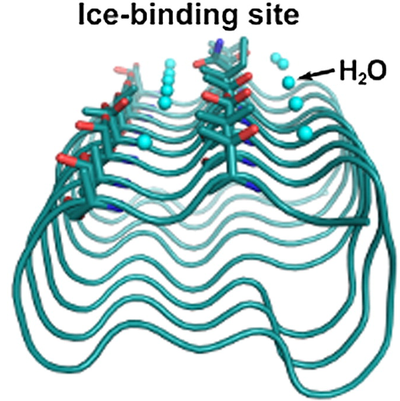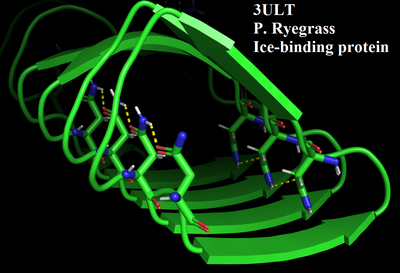IRI3
From Proteopedia
| (3 intermediate revisions not shown.) | |||
| Line 1: | Line 1: | ||
<Structure load='3ult' size='350' frame='true' align='right' caption='Insert caption here' scene='Insert optional scene name here' /> | <Structure load='3ult' size='350' frame='true' align='right' caption='Insert caption here' scene='Insert optional scene name here' /> | ||
| - | [[Image:IceBind 5.png |thumb|400px| The | + | [[Image:IceBind 5.png |thumb|400px| The formation of ice (cyan spheres) is inhibited by the placement of interacting water molecules]] |
| + | [[Image:IceBind 6.png |thumb|400px| A line of asparagines in the center of the roll gives structural stability to the beta-sheet roll motif]] | ||
| + | |||
== Lolium perenne (Perennial ryegrass) Antifreeze/Ice-binding protein IRI3 == | == Lolium perenne (Perennial ryegrass) Antifreeze/Ice-binding protein IRI3 == | ||
| + | |||
| + | Lolium perenne, common name perennial ryegrass is a grass from the family Poaceae. It is native to Europe, Asia and northern Africa, but is widely cultivated and naturalized around the world. Perennial ryegrass is an important pasture and forage plant, and is used in many pasture seed mixes. In fertile soil, it produces a high grass yield. It is commonly used in the southwest United States to overseed winter lawns. | ||
== Structural highlights == | == Structural highlights == | ||
| - | <scene name='10/1080035/Ice-binding_site/1'>Ice-Binding Site</scene> | + | Utilizes it's beta-sheet roll motif to line up several amino acids capable of hydrogen bonding water molecules to form a <scene name='10/1080035/Ice-binding_site/1'>Ice-Binding Site</scene>. These hydrogen bonding amino acids are mostly threonine but also serine and asparagine. The center of the beta sheet roll is stabilized by aspargines hydrogen bonding to one another in a line. |
== References == | == References == | ||
<references/> | <references/> | ||
Middleton AJ, Marshall CB, Faucher F, Bar-Dolev M, Braslavsky I, Campbell RL, Walker VK, Davies PL. Antifreeze protein from freeze-tolerant grass has a beta-roll fold with an irregularly structured ice-binding site. J Mol Biol. 2012 Mar 9;416(5):713-24. doi: 10.1016/j.jmb.2012.01.032. Epub 2012 Jan 28. PMID: 22306740. | Middleton AJ, Marshall CB, Faucher F, Bar-Dolev M, Braslavsky I, Campbell RL, Walker VK, Davies PL. Antifreeze protein from freeze-tolerant grass has a beta-roll fold with an irregularly structured ice-binding site. J Mol Biol. 2012 Mar 9;416(5):713-24. doi: 10.1016/j.jmb.2012.01.032. Epub 2012 Jan 28. PMID: 22306740. | ||
Current revision
|
Lolium perenne (Perennial ryegrass) Antifreeze/Ice-binding protein IRI3
Lolium perenne, common name perennial ryegrass is a grass from the family Poaceae. It is native to Europe, Asia and northern Africa, but is widely cultivated and naturalized around the world. Perennial ryegrass is an important pasture and forage plant, and is used in many pasture seed mixes. In fertile soil, it produces a high grass yield. It is commonly used in the southwest United States to overseed winter lawns.
Structural highlights
Utilizes it's beta-sheet roll motif to line up several amino acids capable of hydrogen bonding water molecules to form a . These hydrogen bonding amino acids are mostly threonine but also serine and asparagine. The center of the beta sheet roll is stabilized by aspargines hydrogen bonding to one another in a line.
References
Middleton AJ, Marshall CB, Faucher F, Bar-Dolev M, Braslavsky I, Campbell RL, Walker VK, Davies PL. Antifreeze protein from freeze-tolerant grass has a beta-roll fold with an irregularly structured ice-binding site. J Mol Biol. 2012 Mar 9;416(5):713-24. doi: 10.1016/j.jmb.2012.01.032. Epub 2012 Jan 28. PMID: 22306740.


